Drum, Percussion
![]() VIETNAM
VIETNAM
![]() CAMBODIA
CAMBODIA
![]() MYANMAR
MYANMAR
![]() THAILAND
THAILAND
![]() LAOS
LAOS
![]() BRUNEI
BRUNEI
![]() JAPAN
JAPAN
Dan Bau 
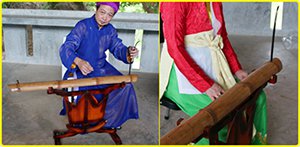
A single-stringed musical instrument, or monochord. It is played by plucking the steel string with one hand, and is distinctive in its use of harmonics. One end of the string is tied to a stem, which is attached perpendicularly to a sound box; the other hand is used to bend the stem, changing the string tension to alter the pitch of the sound. The sound produced is very quiet; today an amplifier is often used to augment the volume.
T’rung 
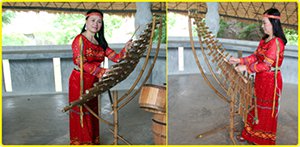
A bamboo xylophone. One distinctive feature of this instrument is its arrangement; bamboo pipes of differing lengths are suspended vertically rather than arranged from left to right. The far end of each pipe is bevelled; this is both to tune the pipe and to enhance the sound produced. It is played by being struck with two hammers, one held in each hand. At times, both ends of a single hammer are used in order to strike two notes at once. The origins of the t'rung are as a traditional musical instrument of ethnic groups living in the Central Highlands of Vietnam. Today, however, it is played widely throughout the whole of Vietnam, having been remodelled by Ba Pho, the husband of Mai Lian, the performer who will be playing the t'rung in the Drums & Voices concerts.
Klong Put 
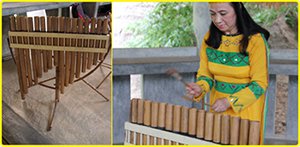
Bamboo pipes of varying lengths are lined up horizontally, similar to a xylophone. This instrument is played by bringing the hands, slightly rounded, together as if clapping, thereby pushing air into the pipes to produce sound. It is unusual in that sound is produced without the player actually touching the instrument. A similar instrument is the dinh pa; here, bamboo pipes are arranged upright and the top ends are struck with a hammer with a flattened end.
Trong Cai 
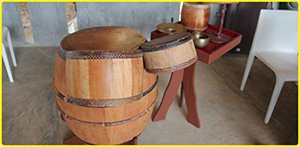
The name of this traditional bass drum literally means “great drum”. The body of the drum is made from jackfruit wood, while the drumhead is made from buffalo hide.
Chaiyam 
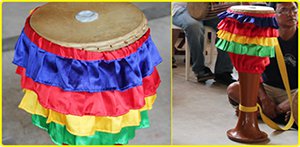
A large drum used in folk performing arts. The body is made from jackfruit wood.
Sampho 
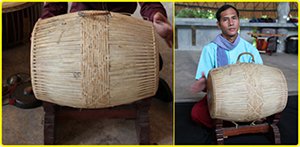
A double-headed drum. The drumheads are made from buffalo or ox hide, tightened with string. The drum is tuned by applying a paste made from rice and ash to the center of the drumheads.
Thon(left), Rammana(right) 
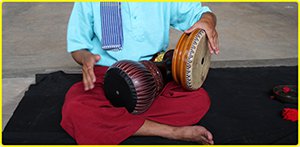
The thon is a small, goblet-shaped drum which is placed on the knees and struck. Snakeskin or elephant-trunk snake skin is used for the drumhead, tightened with rattan string. The rammana is a shallow frame drum, to which the drumhead is tacked with pegs. These two drums are normally played by a single performer.
Hsaing Waing 
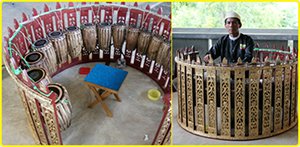
Also known as the pat waing. Ornately carved wooden frames are arranged in a circle, and a set of tuned drums, between 19 and 23 in total, are suspended inside. The player sits in the center of the frame and uses both hands to strike the drums, producing a melody. The drums are tuned by applying a paste made from rice and ash to the center of the drumheads.
Kyi Waing(left), Maung Hsaing(right) 
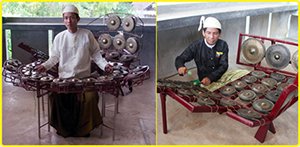
The kyi waing comprises a series of gongs arranged in a circular frame, and the maung hsaing of gongs in a rectangular frame.
Ranad Ek 
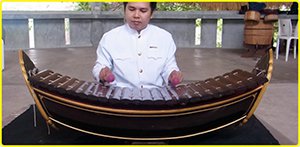
A xylophone consisting of 21-22 bamboo or hardwood sound bars. Ranad is the general term for xylophones, of which there are various sizes; the ranad ek produces sounds in the higher range. The keyboard is suspended by cord onto a boat-shaped body, which functions as a resonating board.
Poengmang Khok 
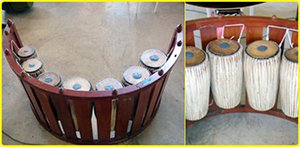
Seven double-headed drums are vertically suspended on a semi-circular wooden frame, and are struck with the hands to produce sound.
Kong Hang 
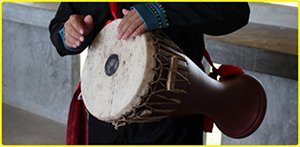
A long, slender drum with a single head. In most cases, the diameter of the drum face is around 20cm, while the length of the body may be more than a meter. The kong hang is often played in parades at festivals; the performer strikes it with the hand while dancing or marching.
Kong Tum 
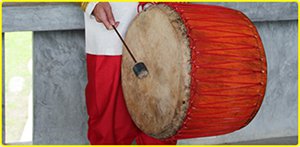
A medium-sized drum. There are two types; one with hide stretched over just one side, and the other with hide stretched over both sides. With the two-headed type, both drumheads are the same size. Normally, a kong tum will be suspended on a pole, and is played by two performers; they strike the drumheads with mallets as they walk. It is often part of parades at rocket festivals, where it forms a set with a buffalo horn flute.
Rebana 
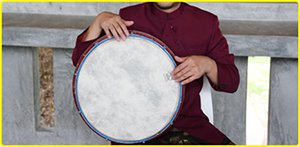
A frame drum played at religious ceremonies in Muslim-majority countries. The name rebana comes from the Arabic word robbana, meaning “our Lord”. The drumhead is made from goat hide. The origins of the drum are thought to lie in the Middle East.
Gendang Labik 
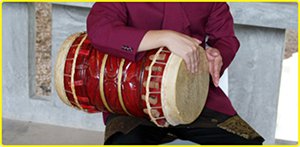
Gendang means “drum”. The gendang labik is a double-headed drum; the player places the middle section of the drum, where the body thins slightly, on the knees and strikes the drumheads with the hands. The drumheads are tied to the body of the drum with rattan string; wedges are driven between the body and the string to tighten the heads.
Tar 
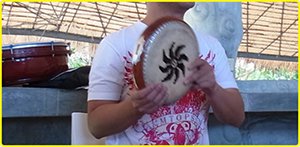
A single-headed drum with zils attached. The origins of this instrument lie in the Middle and Near East; it came to be played in South East Asia together with the introduction of Islam to the region. Tar ensembles accompany song and dance originating in the Middle and Near East.
Wadaiko 
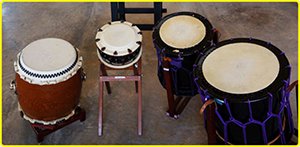
Drums were introduced in Japan in ancient times, and thereafter developed into various forms in the different regions of the country. The current style of performance was devised after World War II. The main differences with the traditional style, in which it was unusual for drummers to perform together, are that drums are brought together into a sort of ‘drum kit’, and that multiple players perform in an ensemble. Modern taiko music combines traditional instruments with a contemporary performance style.
editorial supervisor:Kazuhiko Shima
explanation of Laotian instruments:Etsuo Mushiake
main books for reference:the new grove dictionary of musical instruments
[Contact Us]
The Japan Foundation
Arts and Culture Department, Asia and Oceania Section
Person in charge: Genda (Mr.)/Matsunaga (Mr.)
Tel: +81-(0)3-5369-6062
- What We Do Top
- Arts and Cultural Exchange [Culture]
- Japanese-Language Education Overseas [Language]
- Japanese-Language Education Overseas [Language] Top
- Learn Japanese-language
- Teach Japanese-language
- Take Japanese-Language Test
- Know about Japanese-language education abroad
- The Japanese-Language Institute, Urawa
- The Japanese-Language Institute, Kansai
- Japanese-Language Programs for Foreign Specified Skilled Worker Candidates
- Japanese Language Education for Japanese Children Resident Overseas and for the Descendants of Migrants
- Archives
- Japanese Studies and Global Partnerships [Dialogue]
- JF digital collection
- Other Programs / Programs to Commemorate Exchange Year
- Awards and Prizes
- Publications
